May 7, 2016
New Fury on the Lakes 1/600 Boats!
US
FLA-14 58′ Armored Motor Gunboat………$3.00
FLA-15 Mackinac Class Patrol Gunboat……$8.00
FLA-16 Scaup Class minesweeper…………$7.50
 Scaup Class master. This is based upon the actual USS Bache of 1918
Scaup Class master. This is based upon the actual USS Bache of 1918
RN/Canadian
FLC-17 86′ Drifter w/ 2-14″ torpedoes……..$3.50
FLC-18 Hunt Class Minesweeper Sloop…….$10.00
Pictures of the masters for these new boats can be seen at the PT Dockyard Facebook page HERE
Update February 13
Campaign briefing and Scenario guide available!
More boats coming!
Update December 8
Fury on the Lakes Starter pack!
Rules
Tioga DD
Cricket DD…
Lake freighter
2- Canadian Hickman MTBs
1- Canadian 55′ CMB
2- US Liberty Mk 1 MTB
1- US Liberty Mk 2 MTB
1- US Elco Launch
1- Canadian Vickers Launch
$50.00USD!! Free shipping everywhere.
Fury on the Lakes V1.1 Available December 7

Price:…………………………………………………….$9.95
Order by e-mail to ptdockyard@yahoo.com. You will receive a PayPal invoice and files will be sent after payment
1/600 Fury on the Lakes Miniatures
USA
FLA-1 Greenport Patrol Launch…………..$3.00
FLA-2 Greenport Launch w/ torpedoes…$3.00
FLA-3 Liberty 50′ MTB Mk1……………….$2.00
FLA-4 Elco Patrol Launch………………….$3.50
FLA-5 Tioga Lake Destroyer………………$8.00
FLA-6 40′ Scout boat……………………….$2.00
FLA-7 Armed Barge (3-3″ guns)………….$6.50
FLA-8 Armed Barge (2-4″ guns)………….$6.50
FLA-9 50′ Armored Landing Barge……….$2.50
FLA-10 F-class Submarine………………….$5.00
FLA-11 Liberty 76′ MTB Mk2………………..$3.50
FLA-12 Shearer Submersible MTB (2)……$3.50
FLA-13 1910 Steam Torpedo Launch…….$3.00
At left Elco Launches flanking a Greenport Torpedo Launch. Two 40′ Scout boats at top and at right Three Liberty Mk1 MTBs
Royal Canadian Navy
FLC-1 Yarrow MTB…………………………..$2.50
FLC-2 Vickers Patrol Launch……………….$3.00
FLC-3 Bertram Patrol Launch………………$5.00
FLC-4 Hickman Sea Sled MTB……………..$2.50
FLC-5 Steam Picket Boat (w/torpedoes)..$2.50
FLC-6 Cricket Class Coastal Destroyer…..$8.00
FLC-7 42′ RCMC Patrol boat………………..$2.00
FLC-8 Armored Coastal Monitor……………$3.50
FLC-9 X-lighter (Canadian Version)……..$4.00
FLC-10 70′ CMB Minelayer……………………$3.00
FLC-11 40′ CMB (2)…………………………….$3.50
FLC-12 55′ CMB…………………………………$2.00
FLC-13 55′ Armoured CMB……………………$2.00
FLC-14 C-class submarine……………………$4.00
FLC-15 M-Class Monitor (with 7.5″ gun)……$7.00
FLC-16 M-class Monitor (with 2-6″ guns)…..$7.00
Top-M Class monitor w/7.5″, Bertram Class Patrol Launch
Middle: Hickman Sea Sled MTB, Lake Freighter
Bottom: Vickers Patrol Launch, Yarrow MTB

Merchant Ships
FLM-1 Lake Freighter………………………….$10.00
FLM-2 Tug and 2 barges………………………$8.00
Update 11/14-11/27
Second Playtest game November 23 at Par-a-Dice Games in Rochester NY 6:00PM. This will be a U.S. foray into Georgian Bay in 1918 to disrupt Canadian shipping routes.

Battle Report:
For most of the war, U. S. navy coastal forces had been hamstrung in their efforts to penetrate deep into Georgian Bay by their boats’ short range or slow speed. The fact that the faster US MTBs only carried one torpedo often made a long trip for naught as torpedoes ran erratic or failed to explode.
The delivery of the first 76′ “Big Liberty” boats to squadrons on Lake Huron caused quite a stir and the District command immediately made plans to send these deadly craft, each carrying three 18″ torpedo tubes, deep into Canadian Waters.
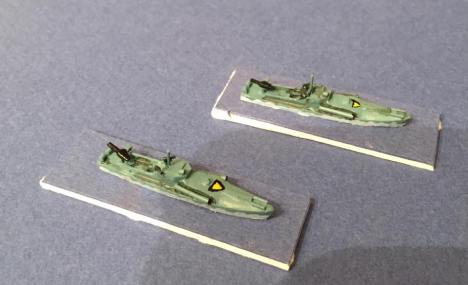
Late in September, Fenian Privateer Flotilla coastwatchers reported a big Canadian convoy sailing East along the north shore of Georgian Bay. This gave the 17th MTB Squadron the opportunity they were waiting for. Five Big Liberties sailed out along with two Greenport gunboats to intercept the convoy in waters the Canadians considered safe. One Greenport had a mechanical failure and had to turn back but the rest of the American craft continued on. Naval aircraft Bombed and strafed Canadian coastal defenses at Tobermory as the boats passed, the aircraft engines providing covering noise for the twenty Liberty engines driving the U.S. MTBs past the Canadian outposts.
The plan was to have the Greenport provide cover from the opposite side of the convoy, distracting the escorts and allowing the Big Liberties to fill the water with torpedoes. Problems arose when the Greenport was moving into position and Canadian Vickers Patrol launch appeared out of the darkness on the port bow. The Canadians were far too early!
The Vickers spotted the Greenport at the same time and both craft began exchanging fire. The Greenport was quickly hit in the engine room by 3pdr fire slowing it down as it wheeled to port and raked both the Vickers and the first freighter in column. Soon the Bertram launch that trailed the Vickers was in range and thrashed the water around the U.S. Boat with 13 pdr and MG fire. A second Bertram launch on the opposite side of the convoy sped up to bring her guns to bear as well.

The Greenport, slowed by the engine hits, poured machine gun and 37mm fire at the Canadian boats. Hits were scored on all and for a few minutes the Greenport led a charmed life. Close range 1pdr, 6pdr and machine gun fire tore at her hull and she sank in a spreading slick of burning fuel.

The Big Liberties, creeping in behind and to the east of the Greenport, spotted the whole convoy at this point. They slowed to a stop and idled, waiting for the convoy to come closer and offer the best torpedo angle. The Canadian escorts, alerted and nervous, began making smoke to cover their charges from whatever lurked in the darkness.
The smoke gave the U.S. Boats the impression they had been spotted. With deafening roars, the five US torpedo boats went to full throttle and charged at the convoy. The two Bertrams began pouring fire out at them, blowing up one Liberty with 13pdr fire but not diverting the Americans from their attack. The American boats headed to a gap in the smoke to bring home their torpedoes.
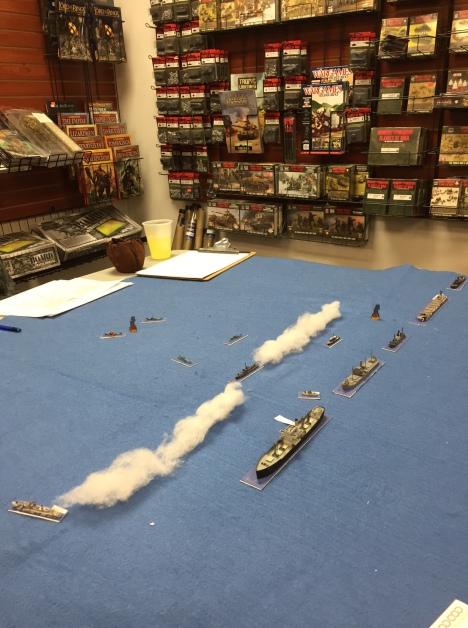
The first 76′ boat loosed her trio of torpedoes at the first and biggest freighter. The fish ran fast but two passed under while the third hit the ship’s side with the resounding clang of a dud. Meanwhile, the third boat in line had a fire break out from 1pdr fire hitting a fuel tank.
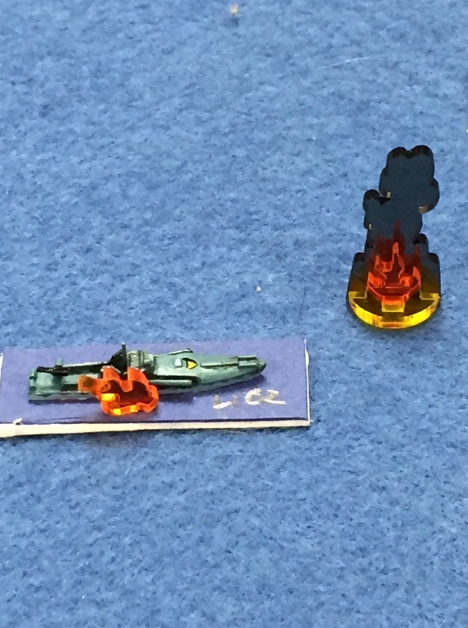
Her big punch spent, the first MTB wheeled west and raced away while the second boat lined up her shot. She ran close and loosed her torpedoes. These too ran hot straight and normal and two fatal hits ripped into the Canadian freighter’s hull. Seconds later this boat was raked by 1pdr fire from a little Constabulary boat, chewing up her empty tubes and disabling the bridge crew. The boat began circling to starboard while the U.S. crew worked to sort out their shattered command center. The Bertrams still kept up the fire and with the bridge crew dead, the remaining crew set the scuttling charges and went over the side.
The third Big Liberty, still fighting her fuel fire, loosed her torpedoes toward the second freighter. Only one hit but that was enough and the freighter began to settle. This boat also suffered the vengeance of the escorts and was abandoned sinking the next turn.

The last American boat went for the only visible target, a big ore boat at the tail of the convoy. Again three torpedo leapt from their tubes and churned toward a Canadian hull. This time two hit, one hitting an empty compartment and the second misfiring and only causing minimal damage. The freighter slowed but continued on.
The final boat to fire joined up with the retiring first boat. Behind them they left three of their sisters along with a shattered Canadian convoy that started the night not really expecting trouble. It was a rough night for all concerned.
The changes to the gunfire rules and the torpedo rules yielded improved results from the last test. Jeff Benedict and John Meredith again ran the boats, this time switching sides from the raid on Oswego. Thanks again to these fine gentlemen and Pair-A Dice Games for hosting the test.
Rules are just about there. I will have to admit it is looking like the first week of so of December for launch but I think everyone will be pleased with the result.
Update 11/3
Rules coming along nicely. Please note release is planned (hopefully for THIS MONTH, not 2016!.
Here are a few shots of new masters
Overview
Over the years, I have read a number of alternative history works that describe
a potential conflict between Great Britain and the United States in the early 20th century. Perhaps the best known is “The Great War: American Front” series by Harry Turtledove and Avalanche Press’ naval board games “Great War At Sea: Plan Crimson and Plan Red. “ This conflict would likely extend to the US and Canada with the naval aspect mostly played out on the Great Lakes. With the actual US War Department War Plans Red (war with Great Britain) and Plan Crimson (war with Canada) along with the Canadian Defense Scheme No. 1, it is apparent this has not only been considered in the minds of novelists alone.
Regarding a conflict on the Great Lakes, however, my thoughts take a different direction. Large battleships would be nice and dramatic but very expensive. With movement from lake to lake by canal hazardous in wartime, large ships would require substantial investment in ships and personnel for each lake. Substantial ice coverage in winter would restrict movement even if these ships had icebreaking features (as icebreaking is not a fast process). This is not to say there would not be some, but whole squadrons may be a stretch. Smaller vessels such as monitors, small destroyers and armed merchants may be more in line with the backwater characteristic of lake warfare and the limited budgets that would be available. The merchant traffic would still continue, protected by minefields to keep the other side’s warships and submarines away. In Turtledove’s series this is how the story played out but in actual history this could be seen in the North Sea Mine Barrage and in the Mediterranean and Gulf of Finland in World War two.
Minefields, however, have not been effective in keeping small MTBs away from coastal traffic. In WW1 British CMBs were specifically designed to skim over the Kaiser’s minefields and take the war to the High Seas Fleet. With “Great Lakes Mosquito War, the PT Dockyard submits that coastal craft would become the most effective force in a hypothetical war on the lakes.
Since reading (nay, devouring) these accounts and novels I have always had interest in someday doing miniatures and rules for a 20th Century Great Lakes naval conflict. Frankly though, the thought of making multiple 1/2400 capital ships was daunting, not to mention the complication of making masters for and casting very tiny smaller ships. The genus of these rules relates back to a visit a few years ago to the Sacket’s Harbor battlefield during a family vacation. While walking the site of an 1813 British raid on the east end of Lake Ontario, the thought came that coastal craft would be well positioned at this base for a Plan Crimson type conflict. In keeping with the stepchild treatment small craft usually get, both in real navies and in the eyes of many who plan and design wargames, it occurred to me that the coastal aspect of a naval war on the Great Lake was an undiscovered country.
Playtest Results Pair A Dice Games Rochester NY,Sept 14
Raid On Oswego April 28, 1918


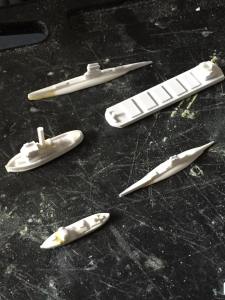

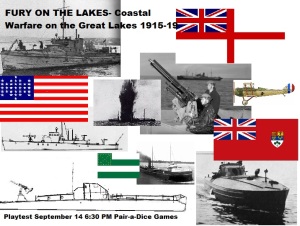
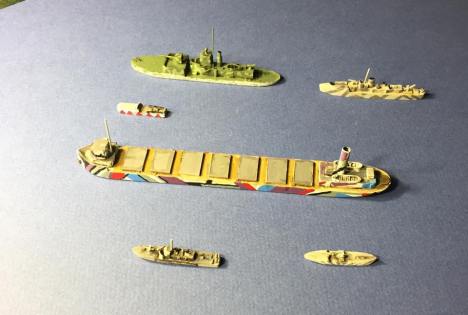
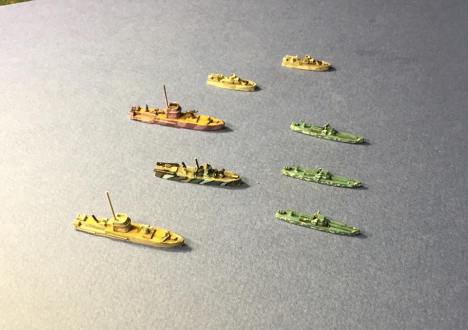

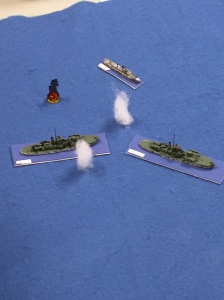







What scale are the ships?
The ships and boats for Fury on the Lakes will be 1/600 scale
What rules did you use?
The rules are available here on the site on the Fury on the Lakes page. They are available as a PDF download for $9.95. If interested please contact me at ptdockyard@yahoo.com